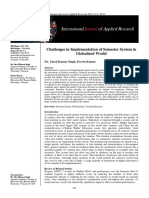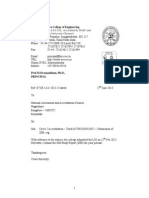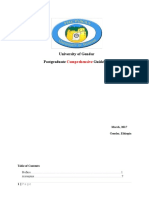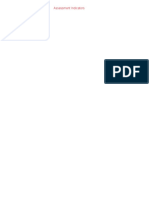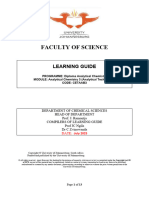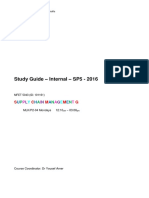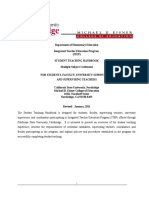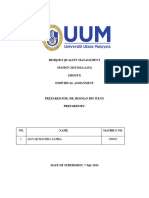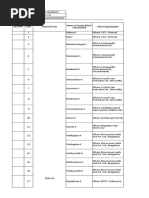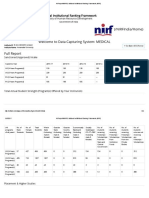Peer Team Report
Peer Team Report
Uploaded by
Sam PeterCopyright:
Available Formats
Peer Team Report
Peer Team Report
Uploaded by
Sam PeterCopyright
Available Formats
Share this document
Did you find this document useful?
Is this content inappropriate?
Copyright:
Available Formats
Peer Team Report
Peer Team Report
Uploaded by
Sam PeterCopyright:
Available Formats
INSTITUTIONAL ASSESSMENT AND ACCREDITATION
(Effective from July 2017)
Accreditation - (Cycle - 3)
PEER TEAM REPORT ON
INSTITUTIONAL ACCREDITATION OF
MANONMANIAM SUNDARANAR UNIVERSITY
TIRUNELVELI
627012
NATIONAL ASSESSMENT AND ACCREDITATION COUNCIL
An Autonomous Institution of the University Grants Commission
P.O. Box No. 1075, Nagarbhavi, Bengaluru - 560 072, INDIA
Page 1/18 17-08-2018 10:04:26
Section I:GENERAL INFORMATION
1.Name & Address of the institution: MANONMANIAM SUNDARANAR UNIVERSITY
TIRUNELVELI
Tamil Nadu
2.Year of Establishment 1990
3.Current Academic Activities at the
Institution(Numbers):
Faculties/Schools: 3
Departments/Centres: 27
Programmes/Course offered: 99
Permanent Faculty Members: 128
Permanent Support Staff: 252
Students: 1421
4.Three major features in the institutional Context 1. Provides access to higher education to poor
(Asperceived by the Peer Team): and down trodden students of three districts of
Tamil Nadu, namely, Tirunelveli, Tuthookudi
and Kanyakumari
2. About 70% of students are female across all
the disciplines
3. Exclusive satellite campuses for Marine
Science at Rajakkamangalam and for
Environmental Sciences at Alwarkurichi.
5.Dates of visit of the Peer Team (A detailed visit Visit Date From : 19-07-2018
schedule may be included as Annexure): Visit Date To : 21-07-2018
6.Composition of Peer Team which undertook the on
site visit:
Chairman: Avinash Chandra
Member Co - ordinator: Professor A M
Member: Shorosimohan
Member: Jai Deo
Member: Saramma
NAAC Co - ordinator: DR. K. RAMA
Page 2/18 17-08-2018 10:04:26
Section II:CRITERION WISE ANALYSIS
Observations (Strengths and/or Weaknesses) on each qualitative metrices of the key Indicator under the
respective criterion(This will be a qualitative analysis of descriptive nature aimed at critical analysis
presenting strength and weakness of HEI under each criteria)
Criterion1 - Curricular Aspects (Key Indicator and Qualitative Metrices(QlM) in Criterion1)
1.1 Curriculum Design and Development
1.1.1 Curricula developed /adopted have relevance to the local/ national / regional/global developmental
QlM needs with learning objectives including program outcomes, program specific outcomes and
course outcomes of all the program offered by the University
1.2 Academic Flexibility
1.3 Curriculum Enrichment
1.3.1 Institution integrates cross cutting issues relevant to Gender, Environment and Sustainability,
QlM Human Values and Professional Ethics into the Curriculum
1.4 Feedback System
Qualitative analysis of Criterion 1
Curricula are designed and developed in a systematic way. Boards of Studies designed the curricula by taking
into consideration regional, national and global developments. Opinion of different stakeholders, including
national and international subject experts is also obtained. Project and field work are important components of
the curricula.
Curricula are revised regularly at an interval of three years. Due emphasis is given to the UGC-NET syllabi
while designing the curricula for all programs. Program output is in consonance with the vision and mission of
the University, but program outcome needs to be further taken care off.
Semester system with CBCS is introduced in all programmes. Focus on employability, entrepreneurship and
skill development is given due importance in most of the academic programmes.
Due emphasis is given on social and human values including cross-cutting issues relevant to gender,
environment etc and Yoga has been introduced as compulsory subject to reduce mental stress of the students.
One subject on “Computer for digital era” has been made mandatory to all UG programmes to enhance
capability of computer usage and modern gadgets. Many value added courses have been introduced during the
last five years to ensure a holistic development of students towards life.
University offers five year integrated programmes in Physics, Mathematics, Chemistry, Electronic Media,
Environmental Science and Marine Science to give emphasis on discipline-focused education and research.
Feedback collected from different stake holders is analyzed and actions are taken accordingly.
Page 3/18 17-08-2018 10:04:26
Criterion2 - Teaching-learning and Evaluation (Key Indicator and Qualitative Metrices(QlM) in Criterion2)
2.1 Student Enrollment and Profile
2.2 Catering to Student Diversity
2.2.1 The institution assesses the learning levels of the students, after admission and organises special
QlM programs for advanced learners and slow learners
2.3 Teaching- Learning Process
2.3.1 Student centric methods, such as experiential learning, participative learning and problem solving
QlM methodologies are used for enhancing learning experiences
2.4 Teacher Profile and Quality
2.5 Evaluation Process and Reforms
2.5.4 Positive impact of reforms on the examination procedures and processes including IT integration
QlM and continuous internal assessment on the examination management system
2.6 Student Performance and Learning Outcomes
2.6.1 Program outcomes, program specific outcomes and course outcomes for all programs offered by
QlM the Institution are stated and displayed on website and communicated to teachers and students
2.6.2 Attainment of program outcomes, program specific outcomes and course outcomes are evaluated
QlM by the institution
2.7 Student Satisfaction Survey
Qualitative analysis of Criterion 2
Admission are done through entrance examinations and reservation policy of the State Government is
followed. But the demand ratio is high in almost all programme except couple of programmes. A structured
mechanism for identification of advanced learners and slow leaners exists and special programmes for
advanced and slow learners are organised.
The University adheres to Academic calendar and the teaching Departments / Centres prepare their teaching
and evaluation plans. Experimental learning, participative learning and problem solving methods are
introduced in MBA and some other programs. As a part of hands-on training industrial visit and educational
tours are blended in almost all the courses. Group discussion, case study etc. encourage the students in
Participative learning. Majority of the teachers uses ICT for effective teaching and learning.
The University has an effective decentralized examination evaluation system. Results are declared on time.
Average pass percentage is about 90%.
Examination management system is computerised.
Continuous internal assessment and adherence to Academic calendar ensure discipline on both teacher and the
Page 4/18 17-08-2018 10:04:26
taught. Provision for providing photo copy of answer books and revaluation has made the examination system
more transparent.
Program outcomes, program specific outcomes and course outcomes needs to be clearly defined and
communicated to all stakeholders.
Academic audit needs to be periodic and it shall be with external experts rather than interal experts.
Page 5/18 17-08-2018 10:04:26
Criterion3 - Research, Innovations and Extension (Key Indicator and Qualitative Metrices(QlM) in
Criterion3)
3.1 Promotion of Research and Facilities
3.2 Resource Mobilization for Research
3.3 Innovation Ecosystem
3.3.1 Institution has created an eco system for innovations including Incubation centre and other
QlM initiatives for creation and transfer of knowledge
3.4 Research Publications and Awards
3.5 Consultancy
3.6 Extension Activities
3.6.1 Extension activities in the neighbourhood community in terms of impact and sensitising students
QlM to social issues and holistic development during the last five years
3.7 Collaboration
Qualitative analysis of Criterion 3
The institution has created an eco-system for quality research and innovation for creation and transfer of
knowledge. Majority of the Departments are engaged in conducting research mainly through their M.Phil &
Ph.D programmes.
Two Departments namely Department of Environmental Sciences and Department of Mathematics are
recognized as Centre of Excellence by the State Government. There are Seven UGC – SAP departments, two
Non-SAP-UGC, Six DST-FIST and one TEQIP & NBHM department. Many Departments have obtained
projects funded by National funding agencies such as DST, DBT, UGC etc., State agency TASCHE.
Department of Environmental Science obtained Rs.5.20 Crores during 2012-17 and Centre for Marine Science
got over Rs.9 Crores. Likewise Department of Biotechnology, Department of Physics and Department of
Mathematics got generous funds for their projects and the some faculties are recipient of state level awards.
The University has generated a sum of Rs.76.75 lakhs through consultancy activities mainly carried out by the
Department of Biotechnology, Chemistry, Mathematics, Physics, Centre for Marine Science & Technology
(CMST) and Department of Communication.
Department of Sri Paramakalyani Centre of Excellence in Environmental Science is particularly worth
mentioning in finding an insect which can specifically consume & permanently destroy the water - hyacinth
which often makes water bodies useless for utility purposes in Tirunelveli and other parts of the country.
Extension activities are carried out in the disaster managements, awareness on social and health related issues
neighborhood community through NSS. Environmental awareness, road safety awareness and programs on
Page 6/18 17-08-2018 10:04:26
women empowerment are organized to sensitize the students on social issues for their holistic development
Page 7/18 17-08-2018 10:04:26
Criterion4 - Infrastructure and Learning Resources (Key Indicator and Qualitative Metrices(QlM) in
Criterion4)
4.1 Physical Facilities
4.1.1 The institution has adequate facilities for teaching - learning. viz., classrooms, laboratories,
QlM computing equipment, etc
4.1.2 The institution has adequate facilities for sports, games (indoor, outdoor),gymnasium, yoga centre
QlM etc., and cultural activities
4.2 Library as a Learning Resource
4.2.1 Library is automated using Integrated Library Management System (ILMS)
QlM
4.2.2 Collection of rare books, manuscripts, special reports or any other knowledge resource for library
QlM enrichment
4.3 IT Infrastructure
4.3.1 Institution frequently updates its IT facilities including Wi-Fi
QlM
4.4 Maintenance of Campus Infrastructure
4.4.2 There are established systems and procedures for maintaining and utilizing physical, academic and
QlM support facilities - laboratory, library, sports complex, computers, classrooms etc.
Qualitative analysis of Criterion 4
The University has 546.98 acres of land at main campus, 116 acres at satellite campuses at Alwarkurichi near
to Tirunelveli & Rajakkamangalam. There are 27 teaching departments, majority of them are having
independent buildings. The infrastructural facility such as class rooms and laboratories are adequate for the
requirements of the existing students. Majority of departments have separate common rooms for girls and
female staff members.
The University has a well maintained administrative block, Controller of Examinations’ Block, Health Centre,
three girls and one boys hostel and one more boys hostel is under construction. There are indoor and outdoor
sports facilities for games and one auditorium for cultural activities and convocation purposes and a
Gymnasium.
There is central library with independent building which contains about one lakh of text and reference books
including some rare ones and is equipped with necessary e-resources. The library is partially automated and is
monitored by a library Advisory Committee. Separate reading and separate section for students shall be made
available exclusively. Teaching department also maintain a small departmental library.
The departments have adequate ICT facilities and the campus is wi-fi enabled. Examination work is fully
computerised. Degree certificate and other documents with large number of security features are in place.
Degree certificate with students profile and semesterwise mark details are encrypted in QR code which is
unique. All faculties are provided with required computers for their work.
Page 8/18 17-08-2018 10:04:26
All the departments are provided uninterrupted power supply and there is adequate water supply. The
University has also a video conferencing system. Imparting of instructions in French, Spanish, Japanese,
Chinese and German are provided through well-equipped Language laboratory.
The University has established systems and procedures for maintenance and utilization of infrastructure
facilities under the supervision of a dedicated Director of Campus Development. The University
progressively increases its budget for maintenance of campus infrastructure.
Page 9/18 17-08-2018 10:04:26
Criterion5 - Student Support and Progression (Key Indicator and Qualitative Metrices(QlM) in Criterion5)
5.1 Student Support
5.1.5 The institution has an active international students cell to cater to the requirements of foreign
QlM students
5.2 Student Progression
5.3 Student Participation and Activities
5.3.2 Presence of an active Student Council & representation of students on academic & administrative
QlM bodies/committees of the institution
5.4 Alumni Engagement
5.4.1 The Alumni Association/Chapters (registered and functional) contributes significantly to the
QlM development of the institution through financial and non financial means during the last five years
Qualitative analysis of Criterion 5
The University has established a Centre for International Students headed by a Professor. The Centre provides
guidance and support to foreign students so that they do not face any difficulty. Special orientation session for
students is conducted to make them familiar with academic programs, examination processes, rules and
regulations etc. The University is constructing a hostel exclusively for foreign students. Presently there are
two foreign students pursuing Ph.D programmes.
University has an active student council. Student representatives are there in BOS, IQAC, Cultural
Committee, Anti-Ragging Committee, Sports Committee, etc.
The University has Anti-Ragging Committee. No case of ragging has reported so far. It has a committee to
look into the grievances relating to sexual harassment. The committee holds its meeting regularly.
Students observe a Sports Day where large number of students participate in different events of sports and
games. A good number of students participated in Sports & cultural events in South Zone Inter University
cultural competition organized by Alagappa University under aegis of Association of Indian Universities
(AIU). Some of the students won prizes also.
The University has a registered Alumni Association, which is active since last 25 years. It helps the University
in different academic affairs and helps the students in their placements. It has contributed a sum of Rs.25 lakhs
for construction of a building of the department of Communication.
Page 10/18 17-08-2018 10:04:26
Criterion6 - Governance, Leadership and Management (Key Indicator and Qualitative Metrices(QlM) in
Criterion6)
6.1 Institutional Vision and Leadership
6.1.1 The governance of the institution is reflective of an effective leadership in tune with the vision and
QlM mission of the University
6.1.2 The institution practices decentralization and participative management
QlM
6.2 Strategy Development and Deployment
6.2.1 Perspective/Strategic plan and Deployment documents are available in the institution
QlM
6.2.2 Organizational structure of the University including governing body, administrative setup, and
QlM functions of various bodies, service rules, procedures, recruitment, promotional policies as well as
grievance redressal mechanism
6.2.4 Effectiveness of various bodies/cells/committees is evident through minutes of meetings and
QlM implementation of their resolutions
6.3 Faculty Empowerment Strategies
6.3.1 The institution has effective welfare measures for teaching and non-teaching staff
QlM
6.3.5 Institution has Performance Appraisal System for teaching and non-teaching staff
QlM
6.4 Financial Management and Resource Mobilization
6.4.1 Institution conducts internal and external financial audits regularly
QlM
6.4.3 Institutional strategies for mobilisation of funds and the optimal utilisation of resources
QlM
6.5 Internal Quality Assurance System
6.5.1 Internal Quality Assurance Cell (IQAC) has contributed significantly for institutionalizing the
QlM quality assurance strategies and processes
6.5.2 The institution reviews its teaching learning process, structures & methodologies of operations and
QlM learning outcomes at periodic intervals through IQAC set up as per norms
6.5.5 Incremental improvements made during the preceding five years (in case of first cycle)
QlM
Post accreditation quality initiatives (second and subsequent cycles)
Qualitative analysis of Criterion 6
The University is governed by Tamil Nadu State Legislature Act and His Excellency the Governor of Tamil
Nadu State is the Chancellor. The University is committed to its Vision and Mission. The Vice-Chancellor
with the help of different committees and administrative staff implements the decisions of the Academic
Council and Syndicate. The University follows decentralized participatory management practices.
Various committees have been formed to look after the routine academic and administrative issues. The
University has different committees such as Internal Complaints Committee, NSS, Anti-Ragging, Grievance
Cell, SC/ST Cell etc. The University has a perspective plan for all round development of the institution which
Page 11/18 17-08-2018 10:04:26
is periodically reviewed.
The University has different welfare schemes on time for the employees. Promotion under CAS is offered
based on Performance Based Appraisal system and monitored by IQAC. Assessment of teachers by student is
done through their feedbacks. IQAC collects student feedbacks which is analyzed and action taken
accordingly.
The University has a well-structured budgetary system and financial management. It conducts internal and
external financial audit. The external audit is conducted by the Comptroller and Accountant General of India.
It takes appropriate steps for effective use of financial resources. The University administration encourages the
teachers to undertake different projects from funding agencies for mobilization of resources for their research
purposes.
The University has taken all steps during the last five years on the basis of the recommendations of the NAAC
Peer Team Cycle II
Page 12/18 17-08-2018 10:04:26
Criterion7 - Institutional Values and Best Practices (Key Indicator and Qualitative Metrices(QlM) in
Criterion7)
7.1 Institutional Values and Social Responsibilities
7.1.2 Institution shows gender sensitivity in providing facilities such as
QlM a) Safety and Security
b) Counselling
c) Common Room
7.1.5 Waste Management steps including:
QlM • Solid waste management
• Liquid waste management
• E-waste management
7.1.6 Rain water harvesting structures and utilization in the campus
QlM
7.1.7 Green Practices
QlM • Students, staff using
a) Bicycles
b) Public Transport
c) Pedestrian friendly roads
• Plastic-free campus
• Paperless office
• Green landscaping with trees and plants
7.1.18 Institution organizes national festivals and birth / death anniversaries of the great Indian
QlM personalities
7.1.19 The institution maintains complete transparency in its financial, academic, administrative and
QlM auxiliary functions
7.2 Best Practices
7.2.1 Describe at least two institutional best practices (as per NAAC Format)
QlM
7.3 Institutional Distinctiveness
7.3.1 Describe/Explain the performance of the institution in one area distinctive to its vision, priority
QlM and thrust
Qualitative analysis of Criterion 7
The institution addresses the issues of gender sensitivity by taking care of the Safety & Security in general and
girls in particular. Different activities are conducted through NSS and Women cell to ensure the safety
precautions. Solid waste management and liquid waste management practices are in place. The idea of ‘Say
no to plastic’ is promoted throughout the campuses.
All the buildings have the rainwater harvesting pits and provision for storage of rain water. About 60%
students and employees use bicycle or public transport for commuting. The University has adopted a project
of “One student one tree” to bring maximum area of the campus under green cover.
The University encourages the students to celebrate important days i.e. Independence Day, Republic Day and
other social festivals. The birth/death anniversaries of great Indian personalities are also observed. The
academic departments also celebrate the days of importance related to their disciplines.
Page 13/18 17-08-2018 10:04:26
To maintain transparency, phone numbers of all important functionaries of the University are given on the
website and displayed at various places. Tender related information is also available on the website. RTI Cell
is exists in the institution and is functional.
As a part of best practices, the University implemented e-governance in examination processes, research and
academic activities to facilitate the students, researchers and other relevant stake holders. The University
encourages transgender students to pursue higher education in colleges and University by waiving their fees.
The University has 1 MW solar photovoltaic power plant connected to grid which is about to be
commissioned shortly. Solar lights are installed along the roads.
Page 14/18 17-08-2018 10:04:26
Section III:OVERALL ANALYSISbased on Institutional strengths.Weaknesses,Opportunities &
Challenges(SWOC)(up to 500 words)
Strength
Strengths:
The University has a good infrastructure facilities, including class rooms, labs, sports facilities etc.
The institution caters to the needs of three districts of Tamil Nadu with two satellite campuses in niche areas
of knowledge.
Ample land resources are available for future expansion for physical infrastructure.
Institutional collaborations with some good institutions
Many Departments are supported financially through FIST and SAP
One MW Solar power plant
High percentage (about 70%) of girl students in all the programs.
“One student-One Tree Project” and promotion of the idea ‘Say no to Plastics” to cover the campus under
green in near future.
Effective and Transparent examination system
Weakness:
Shortage of permanent faculty in some Departments.
High impact factor research publications are yet to be achieved by many departments especially in the faculty
of Arts.
Entrepreneurship cell for promoting local / regional businesses shall be strengthened.
Green practices.
Less number of International students yet to achieved
Opportunities:
To provide soft skills, vocational skills as per the continuously changing requirements of the industries,
MSMEs and self help groups.
Increasing employability potential of students through skill enhancement programmes and value added
programs
To build entrepreneurship and techno-preneurship skills to students to promote start-ups and self-employable
manpower in India.
Page 15/18 17-08-2018 10:04:26
To strengthen the research activities for the grant of National / International Centres of Excellence in thrust
research areas.
The complete web based solution for e-governance of the campuses and affiliated colleges of the University.
To internationalize higher education programmes to facilitate influx of students from other places including
foreign students into the University.
Challenges:
Establishment of new and advanced laboratories for carrying out high quality research
Opening new programs for “holistic education” in catchment area with better employability.
To motivate faculty for sustained efforts for product development, research and innovation leading to
incubation Centre and start – ups.
Keeping pace with changing technological development and requirements of its catchment area.
Functionalizing the MoUs signed to result in annual activities and outcomes.
Intensification of translatable research projects to benefit the society and to improve the economy.
To attract eminent researchers and academicians.
Appointing and retaining quality faculty.
Page 16/18 17-08-2018 10:04:26
Section IV:Recommendations for Quality Enhancement of the Institution
(Please limit to ten major ones and use telegraphic language) (It is not necessary to indicate all the ten
bullets)
The strategic planning for the growth and development of the University needs to be introduced.
More skill-based and job-oriented courses need to be introduced.
University-Industry interface needs to be strengthened.
Coaching for competitive examinations may be arranged for all students instead of weaker section
alone.
Linkages with the society through meaningful interface needs to be further strengthened.
Extension activities for social upliftment and holistic personality development of students needs to be
further strengthened.
Introduction of formal and structured feedback mechanisms from all the stakeholders required.
Faculty members of all departments and Centres need to be encouraged to undertake Research Projects
in emerging interdisciplinary areas.
A centralised sophisticated instrumentation Centre for interdisciplinary and Multidisciplinary advanced
researches needs to be established.
Mentor – Mentee System be formalised.
I have gone through the observations of the Peer Team as mentioned in this report
Signature of the Head of the Institution
Seal of the Institution
Page 17/18 17-08-2018 10:04:26
Sl.No Name Signature with date
1 Avinash Chandra Chairman
2 Professor A M Member Co - ordinator
3 Shorosimohan Member
4 Jai Deo Member
5 Saramma Member
6 DR. K. RAMA NAAC Co - ordinator
Place
Date
Page 18/18 17-08-2018 10:04:26
Powered by TCPDF (www.tcpdf.org)
You might also like
- Allens Cognitive Level Screen ACLS and LACLSDocument7 pagesAllens Cognitive Level Screen ACLS and LACLSKaye Tiu100% (2)
- COPPA 2 New Guidelines On Standards and Criteria FR Accreditation of Dental Degree Programmes 2019Document19 pagesCOPPA 2 New Guidelines On Standards and Criteria FR Accreditation of Dental Degree Programmes 2019Ramesh KumarNo ratings yet
- Peer Team ReportDocument18 pagesPeer Team Reportrakeshkum9165No ratings yet
- AssessmentDocument13 pagesAssessmentJef LeNo ratings yet
- AssessmentDocument13 pagesAssessmentS MalikNo ratings yet
- AssessmentDocument12 pagesAssessmentDasharath MadalbanviNo ratings yet
- NAAC 2018 SSR 3rd CycleDocument119 pagesNAAC 2018 SSR 3rd CyclelvijayanandNo ratings yet
- BPR, Teaching - Learning Process 28113Document83 pagesBPR, Teaching - Learning Process 28113Nebiyu SamuelNo ratings yet
- Vide Item No. 6.37 R The Revised Syllabus of B.E Chemical Engineering Sem. VII VIII CBCS REV 2019 C Scheme.Document123 pagesVide Item No. 6.37 R The Revised Syllabus of B.E Chemical Engineering Sem. VII VIII CBCS REV 2019 C Scheme.fzsiddiqui.keNo ratings yet
- Challenges in Implementation of Semester System in Globalized WorldDocument3 pagesChallenges in Implementation of Semester System in Globalized WorldShakeel AhmadNo ratings yet
- Accreditation Benefits On Teacher Education Programs: The Case of Cebu Technological University Satellite CampusesDocument7 pagesAccreditation Benefits On Teacher Education Programs: The Case of Cebu Technological University Satellite CampusesRiza Mae BayoNo ratings yet
- Gla University, MathuraDocument10 pagesGla University, MathuraAbhishek guptaNo ratings yet
- Checklist For Academic and Administrative Audit: PresentationDocument83 pagesChecklist For Academic and Administrative Audit: Presentationvani100% (1)
- Programme Guide - CNINDocument90 pagesProgramme Guide - CNINSamrat PatilNo ratings yet
- M.SC Chemistry SyllabusDocument39 pagesM.SC Chemistry SyllabusQueenNo ratings yet
- M.A.,M.Sc. Environmental StudiesDocument60 pagesM.A.,M.Sc. Environmental Studiesmanish palNo ratings yet
- RailTel Corporation of India LimitedDocument63 pagesRailTel Corporation of India LimitedOmkarAnnegirikarNo ratings yet
- SSR Naac2013 NbaDocument180 pagesSSR Naac2013 NbakanjaiNo ratings yet
- Ssr-Naac2013 SvecDocument180 pagesSsr-Naac2013 SvecVenkata Rao NekkantiNo ratings yet
- General Guideline - Copy (2) For Final CommentDocument35 pagesGeneral Guideline - Copy (2) For Final CommentR.Ponnusamy100% (5)
- M Lib I SCDocument52 pagesM Lib I SCanjanag15No ratings yet
- Self Study Report: 1 Cycle of AccreditationDocument114 pagesSelf Study Report: 1 Cycle of Accreditationnitesh.ipsNo ratings yet
- RJUNGN104501 After DVV Review 2 12 19Document144 pagesRJUNGN104501 After DVV Review 2 12 19Rocker byNo ratings yet
- 9 Ijasrjun20199Document8 pages9 Ijasrjun20199TJPRC PublicationsNo ratings yet
- NAAC Criteria Wise Assessment IndicatorsDocument19 pagesNAAC Criteria Wise Assessment IndicatorsKrishna Kumar Mishra100% (1)
- CETAAB3 Learner Guide 2023Document13 pagesCETAAB3 Learner Guide 2023henockande4No ratings yet
- Student Perceptions of A Proposed Generic E-LearniDocument9 pagesStudent Perceptions of A Proposed Generic E-LearniMarwan AffandiNo ratings yet
- SCM G Online Study Guide SP5 - 2016 FinalDocument123 pagesSCM G Online Study Guide SP5 - 2016 FinalRamon SampaioNo ratings yet
- 30116-90886-1-PB 3Document16 pages30116-90886-1-PB 3andangsNo ratings yet
- NAAC Criteria For AssessmentDocument23 pagesNAAC Criteria For AssessmentPreeti KalraNo ratings yet
- ITEP Handbook Spring 2011Document49 pagesITEP Handbook Spring 2011Abera MamoNo ratings yet
- Math-3-Trigonometry-SyllabusDocument9 pagesMath-3-Trigonometry-Syllabusfloweryou69No ratings yet
- Print Social&LifeSkillsGuidelines 04012023Document6 pagesPrint Social&LifeSkillsGuidelines 04012023ashishmodak2222No ratings yet
- Original - Modified Quality Scorecard For The Administration of Distance Education ProgramDocument11 pagesOriginal - Modified Quality Scorecard For The Administration of Distance Education ProgramFerdinand Sherwin MorataNo ratings yet
- Cpe 422 - Microprocessors SystemsDocument6 pagesCpe 422 - Microprocessors SystemsJames CENo ratings yet
- Study-guide-Basic-Phase-I-v6Document32 pagesStudy-guide-Basic-Phase-I-v6hedylatif36No ratings yet
- CHINLONE_Dagon UniversityDocument31 pagesCHINLONE_Dagon UniversityThant Shwe AungNo ratings yet
- Faculty Development Plan 1Document3 pagesFaculty Development Plan 1Maniya Dianne ReyesNo ratings yet
- Naac Rar 2016 DduDocument361 pagesNaac Rar 2016 DduMiwcoNo ratings yet
- Article ReportDocument15 pagesArticle ReportAnita DiahNo ratings yet
- Be Automobile Engineering Final Year Be Semester 7 8 Rev 2019 C SchemeDocument94 pagesBe Automobile Engineering Final Year Be Semester 7 8 Rev 2019 C Scheme218102No ratings yet
- GE 217 Science Technology and SocietyDocument9 pagesGE 217 Science Technology and SocietyCheryl RanocoNo ratings yet
- B.ed - 2 Year Modified Syllabus As On 2-7-2018Document267 pagesB.ed - 2 Year Modified Syllabus As On 2-7-2018sreelakshmi psNo ratings yet
- 6040CBGS MU Manual LL - B - 18 19Document54 pages6040CBGS MU Manual LL - B - 18 19Aadarsh JadhavNo ratings yet
- H PG Economics EDocument61 pagesH PG Economics ERupesh NewtonNo ratings yet
- MSc Chemistry Syllabus Aug 2019Document92 pagesMSc Chemistry Syllabus Aug 2019dbs.dbs.ninetyfiveNo ratings yet
- Prospectus 2016 171 PDFDocument67 pagesProspectus 2016 171 PDFNikam AnandNo ratings yet
- Statistics_Refresher_June_2022Document8 pagesStatistics_Refresher_June_2022pgautamsignNo ratings yet
- Distinctiveness MadrasDocument5 pagesDistinctiveness MadrasabhilashNo ratings yet
- Technology and Assessment at Tertiary Level Case of Limkokwing University of Creative TechnologyDocument8 pagesTechnology and Assessment at Tertiary Level Case of Limkokwing University of Creative TechnologyTakura BhilaNo ratings yet
- PG Chemistry Syllabus 2022-2025Document88 pagesPG Chemistry Syllabus 2022-2025jeevananthampchpa23008No ratings yet
- Program Audit Training - StandardsDocument60 pagesProgram Audit Training - StandardsgizawNo ratings yet
- AiP TruncaleChalkPellegrinoKemmerlingMarch2018 PDFDocument7 pagesAiP TruncaleChalkPellegrinoKemmerlingMarch2018 PDFDiana CortejasNo ratings yet
- EECE - General - Study - Guide (Current)Document60 pagesEECE - General - Study - Guide (Current)Katlego MaganoNo ratings yet
- NSSCO Chemistry SyllabusDocument52 pagesNSSCO Chemistry SyllabusEbic GamerNo ratings yet
- 1 s2.0 S1877042811011967 MainDocument10 pages1 s2.0 S1877042811011967 MainWEBSTER SARAOSNo ratings yet
- Training Needs For Faculty Members: Towards Achieving Quality of University Education in The Light of Technological InnovationsDocument14 pagesTraining Needs For Faculty Members: Towards Achieving Quality of University Education in The Light of Technological InnovationsAinul Bari MalithaNo ratings yet
- Bed Pros xf16 MayDocument149 pagesBed Pros xf16 MayDevrajBhattacharjeeNo ratings yet
- CDI-2 Traffic InvestigationDocument8 pagesCDI-2 Traffic InvestigationTfig Fo EcaepNo ratings yet
- ICT Project Management: Framework for ICT-based Pedagogy System: Development, Operation, and ManagementFrom EverandICT Project Management: Framework for ICT-based Pedagogy System: Development, Operation, and ManagementNo ratings yet
- Educational Assessment: Principles and Practices: Innovative Education: Strategies, Challenges, and Solutions in PedagogyFrom EverandEducational Assessment: Principles and Practices: Innovative Education: Strategies, Challenges, and Solutions in PedagogyNo ratings yet
- Institute Name: Manonmaniam Sundaranar University, Tirunelveli (IR-O-U-0464)Document23 pagesInstitute Name: Manonmaniam Sundaranar University, Tirunelveli (IR-O-U-0464)Sam PeterNo ratings yet
- Institutional Assessment and Accreditation (Effective From July 2017) Accreditation - (Cycle: 3)Document5 pagesInstitutional Assessment and Accreditation (Effective From July 2017) Accreditation - (Cycle: 3)Sam PeterNo ratings yet
- Parameter Consultancy Projects 2D.Fppp S.No. Financial Year Client Organization Name of Faculty (Chief Consultant)Document18 pagesParameter Consultancy Projects 2D.Fppp S.No. Financial Year Client Organization Name of Faculty (Chief Consultant)Sam PeterNo ratings yet
- Institute Name Annamalai University India Rankings 2017 ID IR17-COLL-2-1-33 Discipline Arts/Humanities/ScieDocument3 pagesInstitute Name Annamalai University India Rankings 2017 ID IR17-COLL-2-1-33 Discipline Arts/Humanities/ScieSam PeterNo ratings yet
- Institute Name: Manonmaniam Sundaranar University (IR-O-U-0464)Document11 pagesInstitute Name: Manonmaniam Sundaranar University (IR-O-U-0464)Sam PeterNo ratings yet
- Institute Name Annamalai Universit India Rankings 2017 ID IR17-COLL-2-1-33 Discipline Arts/Humanities/SciDocument3 pagesInstitute Name Annamalai Universit India Rankings 2017 ID IR17-COLL-2-1-33 Discipline Arts/Humanities/SciSam PeterNo ratings yet
- (/Nirfindia/Home) Welcome To Data Capturing System: College Full ReportDocument72 pages(/Nirfindia/Home) Welcome To Data Capturing System: College Full ReportSam PeterNo ratings yet
- (/Nirfindia/Home) Welcome To Data Capturing System: Overall Full ReportDocument18 pages(/Nirfindia/Home) Welcome To Data Capturing System: Overall Full ReportSam PeterNo ratings yet
- (/Nirfindia/Home) Welcome To Data Capturing System: Engineering Full ReportDocument39 pages(/Nirfindia/Home) Welcome To Data Capturing System: Engineering Full ReportSam PeterNo ratings yet
- (/Nirfindia/Home) Welcome To Data Capturing System: Pharmacy Full ReportDocument12 pages(/Nirfindia/Home) Welcome To Data Capturing System: Pharmacy Full ReportSam PeterNo ratings yet
- (/Nirfindia/Home) Welcome To Data Capturing System: Pharmacy Full ReportDocument11 pages(/Nirfindia/Home) Welcome To Data Capturing System: Pharmacy Full ReportSam PeterNo ratings yet
- (/Nirfindia/Home) Welcome To Data Capturing System: Management Full ReportDocument17 pages(/Nirfindia/Home) Welcome To Data Capturing System: Management Full ReportSam PeterNo ratings yet
- OverallDocument138 pagesOverallSam PeterNo ratings yet
- First Semester: University of Madras B.Music Degree Course W.E.F.2008-2009Document21 pagesFirst Semester: University of Madras B.Music Degree Course W.E.F.2008-2009Sam Peter0% (1)
- (/Nirfindia/Home) Welcome To Data Capturing System: Medical Full ReportDocument24 pages(/Nirfindia/Home) Welcome To Data Capturing System: Medical Full ReportSam PeterNo ratings yet
- Institute Name: Annamalai University (IR-E-U-0443)Document17 pagesInstitute Name: Annamalai University (IR-E-U-0443)Sam PeterNo ratings yet
- (/Nirfindia/Home) Welcome To Data Capturing System: Medical Full ReportDocument22 pages(/Nirfindia/Home) Welcome To Data Capturing System: Medical Full ReportSam PeterNo ratings yet
- Institute Name: Annamalai University (IR-N-U-0443)Document3 pagesInstitute Name: Annamalai University (IR-N-U-0443)Sam PeterNo ratings yet
- Institute Name: Annamalai University (IR-G-U-0443)Document15 pagesInstitute Name: Annamalai University (IR-G-U-0443)Sam PeterNo ratings yet
- (/Nirfindia/Home) Welcome To Data Capturing System: Engineering Full ReportDocument33 pages(/Nirfindia/Home) Welcome To Data Capturing System: Engineering Full ReportSam PeterNo ratings yet
- HonoursDocument36 pagesHonoursSam PeterNo ratings yet
- University of Madras (With Effect From The Academic Year 2016-2017) Annexure-Ii Revised Scheme of Examination: Semester IDocument41 pagesUniversity of Madras (With Effect From The Academic Year 2016-2017) Annexure-Ii Revised Scheme of Examination: Semester ISam PeterNo ratings yet
- Institute Name: Annamalai University (IR-O-U-0443)Document70 pagesInstitute Name: Annamalai University (IR-O-U-0443)Sam PeterNo ratings yet
- BIMDocument50 pagesBIMSam PeterNo ratings yet
- Co-OpDocument31 pagesCo-OpSam PeterNo ratings yet
- Institute Name: Annamalai University (IR-P-U-0443)Document6 pagesInstitute Name: Annamalai University (IR-P-U-0443)Sam PeterNo ratings yet
- B.A. Degree Courses in Sanskrit First Semester: Non-Tamil Students - Tamil Tamil Students - NonDocument12 pagesB.A. Degree Courses in Sanskrit First Semester: Non-Tamil Students - Tamil Tamil Students - NonSam PeterNo ratings yet
- B.A.Tourism and Travel Management PDFDocument23 pagesB.A.Tourism and Travel Management PDFSam PeterNo ratings yet
- University of Madras B.A. Degree Course in Sociology (With Effect From The Academic Year 2008-2009)Document25 pagesUniversity of Madras B.A. Degree Course in Sociology (With Effect From The Academic Year 2008-2009)Sam PeterNo ratings yet
- B.A.Tourism and Travel Management PDFDocument23 pagesB.A.Tourism and Travel Management PDFSam PeterNo ratings yet
- Exploring Value Propositions and Service Innovation: A Service-Dominant Logic StudyDocument22 pagesExploring Value Propositions and Service Innovation: A Service-Dominant Logic StudyPreksha DhaneshaNo ratings yet
- Hannah Stern Letter of RecDocument1 pageHannah Stern Letter of Recapi-339309940No ratings yet
- Guidelines For Taking The Big Five Personality TestDocument4 pagesGuidelines For Taking The Big Five Personality TestEeng VitriNo ratings yet
- Management Support Systems - Knowledge Acquisition, Representation, and ReasoningDocument46 pagesManagement Support Systems - Knowledge Acquisition, Representation, and ReasoningDr Rushen SinghNo ratings yet
- Topic 4 - EDN550 - 2023 - ST3 - LectureDocument10 pagesTopic 4 - EDN550 - 2023 - ST3 - LecturestgregNo ratings yet
- Foucauldian EducationDocument13 pagesFoucauldian EducationSebastian LeonNo ratings yet
- Planificari Unitati de Invatare XDocument6 pagesPlanificari Unitati de Invatare XOana MarinNo ratings yet
- Las Module 1Document1 pageLas Module 1Menchie D. LegaspiNo ratings yet
- Integrated Lessons Block Plan: LessonDocument2 pagesIntegrated Lessons Block Plan: Lessonapi-380697729No ratings yet
- PosterDocument1 pagePosterapi-534759733No ratings yet
- MODULE in EUTHENICS UNIT 1 Topic 2Document6 pagesMODULE in EUTHENICS UNIT 1 Topic 2Princess Sarah Mae AmistadNo ratings yet
- Fractions LessonDocument3 pagesFractions Lessonapi-299379997No ratings yet
- Chapter 4Document17 pagesChapter 4ZiziNo ratings yet
- GED 109 - Inquiry-Based ProjectDocument2 pagesGED 109 - Inquiry-Based ProjectMaila PaguyanNo ratings yet
- Brandi T Sweat ResumeDocument3 pagesBrandi T Sweat Resumeapi-256635702No ratings yet
- An Analysis On The Effects of Role-Playing Games On The Reading Comprehension of College Students at Laguna State Polytechnic UniversityDocument54 pagesAn Analysis On The Effects of Role-Playing Games On The Reading Comprehension of College Students at Laguna State Polytechnic UniversityEdward DimaanoNo ratings yet
- DLL Science Quarter 1 Week 3Document4 pagesDLL Science Quarter 1 Week 3Vincent O GadianNo ratings yet
- Ana Maria Mincan EnglezaDocument6 pagesAna Maria Mincan EnglezaBluehelenNo ratings yet
- Review On Criminological ResearchDocument64 pagesReview On Criminological ResearchTIPAY, EMELIE L.100% (2)
- Artif 2 Edcu 623 Final Paper Teacher LeaderDocument11 pagesArtif 2 Edcu 623 Final Paper Teacher Leaderapi-320388695No ratings yet
- Entrepreneurial Stress and Long Term Survival - Is There A Causal LinkDocument11 pagesEntrepreneurial Stress and Long Term Survival - Is There A Causal LinkArinze7No ratings yet
- Unit 2 Goal SettingDocument23 pagesUnit 2 Goal Settingsharath haradyNo ratings yet
- Need Goal DriveDocument2 pagesNeed Goal DriveKaelaNo ratings yet
- Investigating Foreign Language Learning Anxiety Among Students Learning English in A Public Sector University, PakistanDocument11 pagesInvestigating Foreign Language Learning Anxiety Among Students Learning English in A Public Sector University, PakistanSiti FauziahNo ratings yet
- Introduction To HumanitiesDocument6 pagesIntroduction To HumanitiesMarydel LomugdangNo ratings yet
- BGT 2-1Document65 pagesBGT 2-1Alvina IrfanNo ratings yet
- Heart DiseaseDocument10 pagesHeart Diseaserahinikasiraj0% (1)
- The Development of Comparative PoliticsDocument24 pagesThe Development of Comparative PoliticsLaura HioniaNo ratings yet
- Aliswag - PDF Dec 17 SeminarDocument6 pagesAliswag - PDF Dec 17 SeminarGilbert EnriquezNo ratings yet









